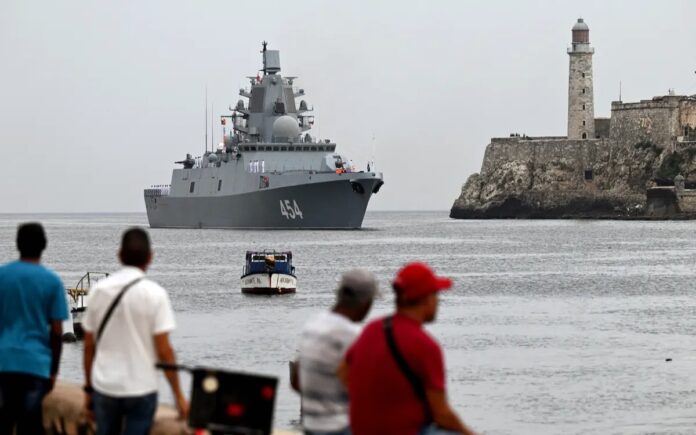Havana: Russia’s decision to deploy a fleet of warships to Havana, Cuba, is viewed as a strategic display of strength in the region, heightening existing tensions with Western nations over the Ukraine conflict.
Early Wednesday (June 12), four vessels, including the nuclear-powered submarine Kazan and the frigate Admiral Gorshkov, entered Havana Bay. Upon arrival, the warships fired a ceremonial 21-gun salute, reciprocated from the battlements of La Cabaña, historically significant as Che Guevara’s former office.
During their journey to Cuba this week, the Gorshkov and Kazan conducted missile drills in the Atlantic, testing precision missiles with a range exceeding 600 kilometers (370 miles), as reported by Russia’s Ministry of Defence. Cuban officials emphasized that visits from allied nations are routine and clarified that the Kazan carried no nuclear armament, asserting there was no regional threat.
The proximity of Havana to Key West, Florida, underscores the timing of this visit as more than routine, noted William LeoGrande, a professor at American University. “The Russian warships visiting the region are Putin’s way of reminding Joe Biden that Moscow can challenge Washington in its own sphere of influence,” LeoGrande remarked to the international news agency AP.
The Kazan and Gorshkov, commissioned in 2017 and 2018 respectively, represent some of Russia’s most advanced naval assets. The Kazan submarine is reputed as the quietest in the Russian navy, while the Gorshkov frigate is capable of carrying the latest Zircon hypersonic missiles, according to Russian admiralty sources.
Also Read | Moscow Issues Stark Warning Over New US Sanctions
Departing from their home port in Russia’s Kola Peninsula in mid-May, the vessels also include the tanker Pashin and the rescue tug Nikolai Chiker.
The presence of US military vessels and aircraft in the Atlantic and Caribbean underscores American vigilance. The US Navy, including ships like USS Truxtun and USS Donald Cook, alongside the US Coast Guard vessel USCGC Stone, has monitored the Russian fleet’s movements. A P-8 Poseidon reconnaissance plane and other air assets have conducted surveillance overhead.
Also Read | Canada to Send 2,000 Unarmed Rockets and Military Supplies to Ukraine Amid Ongoing Conflict
Canadian authorities have also deployed resources to monitor the situation, highlighting international interest and concern over the developments.
Pentagon and State Department officials have characterized Russian naval activities as routine and non-threatening to US interests, citing Cuba’s history of hosting Russian ships annually from 2013 to 2020.



